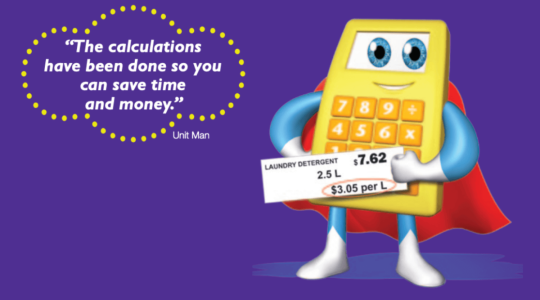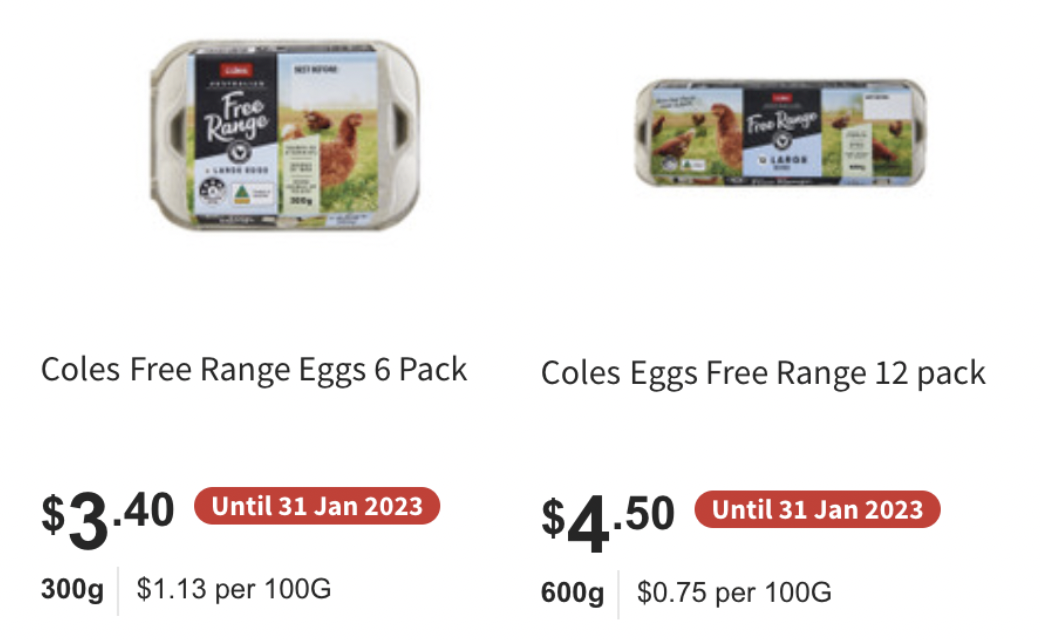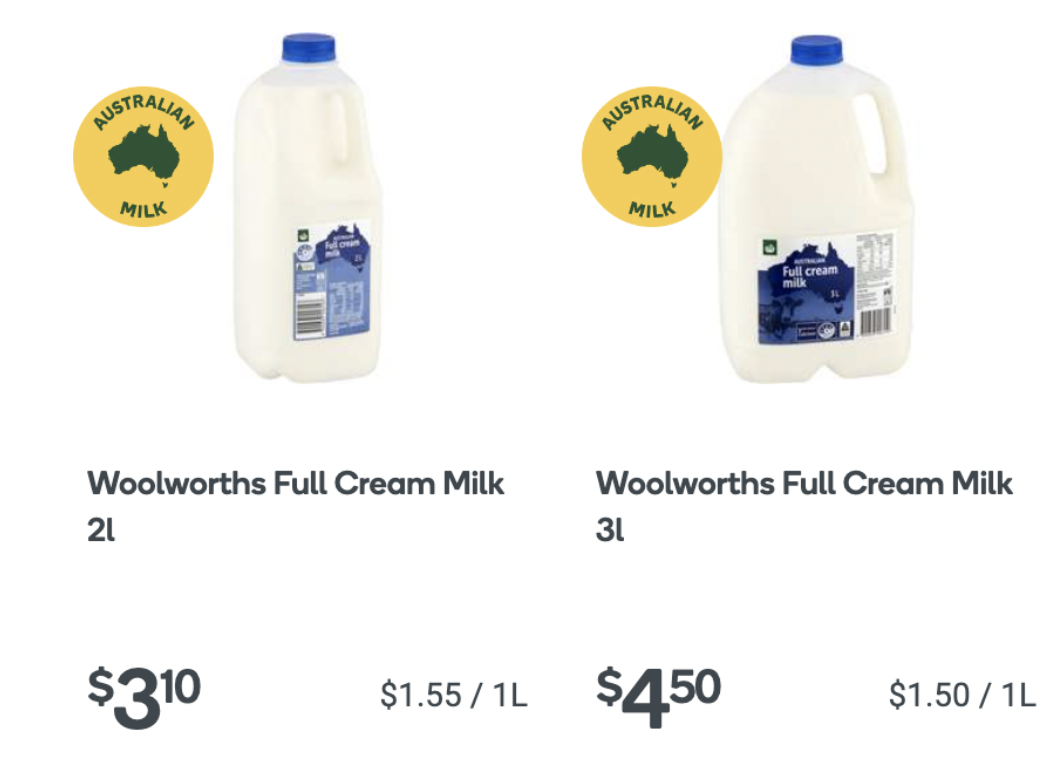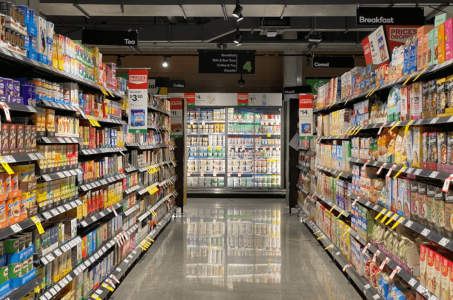Unit Pricing 101: How to Shop Smarter for Groceries
- Replies 7
As our members are no doubt aware, groceries are an unavoidable cost of living. But, no matter where you live, rising prices have been a big issue for many Australians lately.
Just in the last 12 months, the cost of fruit and vegetables has increased by 16.2%, bread and cereal products by 10%, and meat and seafood by 7.3%.
This means each meal costs us more and more.
But while we're all looking for ways to save money, many of us tend to forget to pay attention to the biggest detail in supermarkets – the prices!
We get attracted to sales promotions, fancy displays, and seemingly low prices. That's all well and good, but if we're not careful, it's easy to miss out on even better deals.
The real way to save money is to look out for unit prices!
Credit: ACCC.
What is unit pricing, you ask?
Unit pricing is a labelling system that is required by law (under the Competition and Consumer Act 2010) and helps shoppers understand the cost of a product. It shows the price of the product per unit of measurement, such as per litre, gram, or kilogram.
This way, shoppers can compare prices of similar products, even if they come in different sizes, brands, or packaging. Unit prices are calculated to the nearest dollar and cent, making it easy for you to compare and find the best deal on groceries.
This is also useful for comparing products online since you don't have the opportunity to physically inspect them and make a comparison before buying.
Not convinced? Let's look at the numbers.
In a recent study by CHOICE with over a thousand grocery shoppers, it was found that when unit pricing information was included, the selection of the best-value product increased to 74%.
Without it, only 60% of shoppers were able to pick the cheaper option. That's a difference of 14%!
In the same survey, 44% of respondents told researchers that they were using unit pricing to reduce their grocery spending during the last 6 months. 23% even said that in their opinion, comparing unit prices was the best way to get the best value for money.
As it stands, more than 80% of people are already using the system regularly. Encouragingly, a whopping 97% of this group also said that unit pricing was useful in helping them save money.

But why aren't more of us using it?
According to the survey, many shoppers find unit pricing useful for saving money, but they also face challenges when using it.
When shopping in stores, 71% of shoppers reported problems with unit pricing. 35% reported that the unit price was not displayed, 34% found it hard to read, and 31% found it covered or obstructed by another label.
Online shopping also presents challenges for unit pricing. One in four online shoppers who use unit pricing find it difficult to compare products side by side. One in five can't sort or search for the lowest unit prices, and nearly a third have trouble with different units of measurement for the same type of product.
Consumer advocate Ian Jarratt says this is a real shame, and that supermarkets need to make unit pricing easier for their customers.
'Supermarkets make sure you can read the selling price of a product, yet the unit price is the only one they are required by law to display prominently and legibly,' he says.
'Supermarkets need to make it much easier for consumers to notice, read, understand and use the unit prices. They should be prominent and legible wherever the product is displayed, whether that's on the top, middle or bottom shelves.'
But Ian also adds that it's up to us to look out for the best value and use unit pricing while shopping.

How is unit pricing displayed?
Here are the standard unit price measurements for various types of grocery items.
Keep in mind that this list may not apply to all grocery products. Fruit, vegetables, meat, and seafood which are (generally) sold by weight, usually show the unit price per kilogram or per item. On the other hand, beverages such as milk and cordial are priced per litre.
Now that you know how unit prices are displayed in supermarkets, here's how to use them to compare grocery prices.
For example, let's say you want to compare eggs. In this case, the larger carton of eggs from Coles might cost more, but it has a lower unit price of $0.75 per 100g, making it a better value compared to the smaller carton with six eggs, which has a unit price of $1.13 per 100g.

Credit: Coles.
Let's use milk as another example. Here we can see that Woolworths Full Cream Milk 2L has a unit price of $1.55 per litre, while the 3L variant has a unit price of $1.50 per litre. This means that going for the larger size may give you more value for your money.

Credit: Woolworths.
 To find the unit price of a product when it's not listed, use this formula:
To find the unit price of a product when it's not listed, use this formula:

Ian Jarratt has been a passionate champion for the provision of unit pricing for years now, and he has observed that many shoppers are still easily swayed by sale prices. He believes this tendency is concerning and highlights the need for shoppers to be savvier with their spending using tools like unit pricing.
'Unit pricing is the only tool that covers all of the many value comparisons you want to make,' he explains.
'Given the amount of advertising of products on sale, comparing unit prices is still considered to be one of the best ways to get value.'
Do sale items have unit pricing? Yes, unit pricing must be shown even on sale items, including buy one get one free deals and when multiple items are sold at a bundled price (e.g. two bottles of soft drink for $5 or four tuna cans for $3).
However, retailers are not required to display unit pricing in the following cases:

You read it here, folks! Next time you're grocery shopping, don't be distracted by the 'sales' and the clever packaging - instead, head straight for the small text, below the selling price, and use it to start saving money on your grocery bills.
In addition to using unit pricing, CHOICE has previously recommended incorporating simple tips into your grocery shopping routine to potentially save hundreds or even thousands of dollars on your bills. Check out this article for more information!
What do you think of this, members? Do you use and check unit pricing when you shop? Do you think it's useful when it comes to saving money? Let us know in the comments below!
Just in the last 12 months, the cost of fruit and vegetables has increased by 16.2%, bread and cereal products by 10%, and meat and seafood by 7.3%.
This means each meal costs us more and more.
But while we're all looking for ways to save money, many of us tend to forget to pay attention to the biggest detail in supermarkets – the prices!
We get attracted to sales promotions, fancy displays, and seemingly low prices. That's all well and good, but if we're not careful, it's easy to miss out on even better deals.
The real way to save money is to look out for unit prices!
Credit: ACCC.
What is unit pricing, you ask?
Unit pricing is a labelling system that is required by law (under the Competition and Consumer Act 2010) and helps shoppers understand the cost of a product. It shows the price of the product per unit of measurement, such as per litre, gram, or kilogram.
This way, shoppers can compare prices of similar products, even if they come in different sizes, brands, or packaging. Unit prices are calculated to the nearest dollar and cent, making it easy for you to compare and find the best deal on groceries.
This is also useful for comparing products online since you don't have the opportunity to physically inspect them and make a comparison before buying.
Not convinced? Let's look at the numbers.
In a recent study by CHOICE with over a thousand grocery shoppers, it was found that when unit pricing information was included, the selection of the best-value product increased to 74%.
Without it, only 60% of shoppers were able to pick the cheaper option. That's a difference of 14%!
In the same survey, 44% of respondents told researchers that they were using unit pricing to reduce their grocery spending during the last 6 months. 23% even said that in their opinion, comparing unit prices was the best way to get the best value for money.
As it stands, more than 80% of people are already using the system regularly. Encouragingly, a whopping 97% of this group also said that unit pricing was useful in helping them save money.

When shoppers were asked how they were reducing their grocery spending, comparing unit pricing was one of the top answers. Credit: Unsplash/Viki Mohamad.
But why aren't more of us using it?
According to the survey, many shoppers find unit pricing useful for saving money, but they also face challenges when using it.
When shopping in stores, 71% of shoppers reported problems with unit pricing. 35% reported that the unit price was not displayed, 34% found it hard to read, and 31% found it covered or obstructed by another label.
Online shopping also presents challenges for unit pricing. One in four online shoppers who use unit pricing find it difficult to compare products side by side. One in five can't sort or search for the lowest unit prices, and nearly a third have trouble with different units of measurement for the same type of product.
Consumer advocate Ian Jarratt says this is a real shame, and that supermarkets need to make unit pricing easier for their customers.
'Supermarkets make sure you can read the selling price of a product, yet the unit price is the only one they are required by law to display prominently and legibly,' he says.
'Supermarkets need to make it much easier for consumers to notice, read, understand and use the unit prices. They should be prominent and legible wherever the product is displayed, whether that's on the top, middle or bottom shelves.'
But Ian also adds that it's up to us to look out for the best value and use unit pricing while shopping.

By using standard units of measure, shoppers can easily compare the price of products, regardless of different sizes or brands. Credit: ACCC.
How is unit pricing displayed?
Here are the standard unit price measurements for various types of grocery items.
| Items sold by | Unit pricing measurement | Product examples |
| Weight | Per 100 grams | Rice, soup, pasta, and spreads |
| Capacity or volume | Per 100 millilitres | Salad dressing, sauces, and cooking creams |
| Length | Per metre | Wrapping paper |
| By number | Per item included (each) | Cleaning cloths and sponges |
Keep in mind that this list may not apply to all grocery products. Fruit, vegetables, meat, and seafood which are (generally) sold by weight, usually show the unit price per kilogram or per item. On the other hand, beverages such as milk and cordial are priced per litre.
Now that you know how unit prices are displayed in supermarkets, here's how to use them to compare grocery prices.
For example, let's say you want to compare eggs. In this case, the larger carton of eggs from Coles might cost more, but it has a lower unit price of $0.75 per 100g, making it a better value compared to the smaller carton with six eggs, which has a unit price of $1.13 per 100g.
Credit: Coles.
Let's use milk as another example. Here we can see that Woolworths Full Cream Milk 2L has a unit price of $1.55 per litre, while the 3L variant has a unit price of $1.50 per litre. This means that going for the larger size may give you more value for your money.
Credit: Woolworths.
Tip
Keep in mind that buying in bulk or on sale doesn't always mean you're getting a good deal. The same goes for store-brand products. Unit pricing helps you compare all products fairly and determine which one gives you the best value, whether it be fresh produce, canned goods, or frozen foods.
- Take the price of an item
- Divide that price by the unit pricing measurement
- Liquid item A costs $7.50 for a 2.5-litre bottle, so the unit price is $7.50 ÷ 2.5 = $3 per litre.
- Liquid item B costs $6.20 for a 1.5-litre bottle, so the unit price is $6.20 ÷ 1.5 = $4.13 per litre.

Supermarkets need to do more to help shoppers properly compare product prices. Credit: Unsplash/Franki Chamaki.
Ian Jarratt has been a passionate champion for the provision of unit pricing for years now, and he has observed that many shoppers are still easily swayed by sale prices. He believes this tendency is concerning and highlights the need for shoppers to be savvier with their spending using tools like unit pricing.
'Unit pricing is the only tool that covers all of the many value comparisons you want to make,' he explains.
'Given the amount of advertising of products on sale, comparing unit prices is still considered to be one of the best ways to get value.'
Do sale items have unit pricing? Yes, unit pricing must be shown even on sale items, including buy one get one free deals and when multiple items are sold at a bundled price (e.g. two bottles of soft drink for $5 or four tuna cans for $3).
However, retailers are not required to display unit pricing in the following cases:
- When different items are sold together as a package (such as a meal kit with different ingredients)
- When similar items of varying sizes or weights are sold at a single price (e.g. chocolates of different sizes sold for $2)
- When the product is discounted due to damaged packaging, close to expiration, or being discontinued.
Key Takeaways
- Grocery costs have risen significantly in the last 12 months and experts predict further increases.
- Using unit pricing when shopping can help maximise your budget by finding the best deal.
- Following a survey, it was found that unit pricing is useful and 80% of shoppers who are aware of it use it regularly.
- However, difficulties in reading the unit price and comparing products of interest side-by-side online were found by shoppers.
- To find the unit price of a product when it's not listed, simply take the price of an item and divide that price by the unit pricing measurement.
In addition to using unit pricing, CHOICE has previously recommended incorporating simple tips into your grocery shopping routine to potentially save hundreds or even thousands of dollars on your bills. Check out this article for more information!
What do you think of this, members? Do you use and check unit pricing when you shop? Do you think it's useful when it comes to saving money? Let us know in the comments below!







